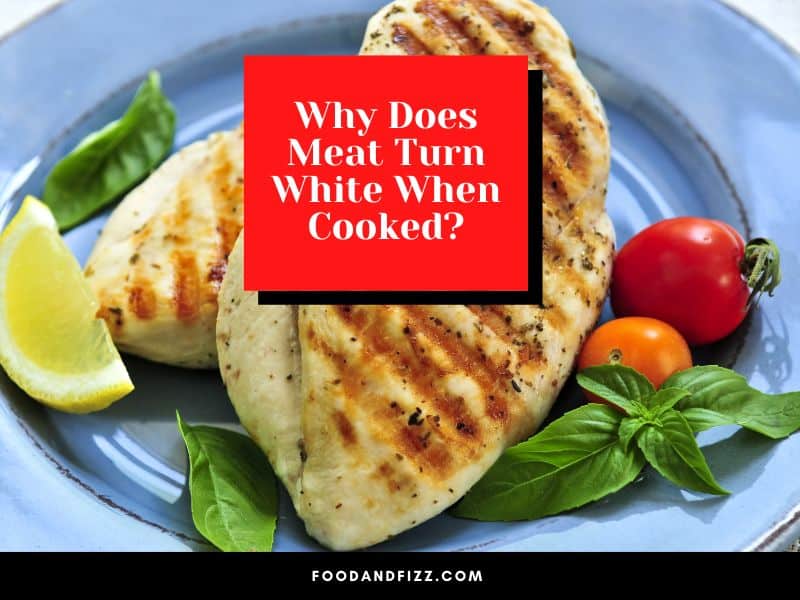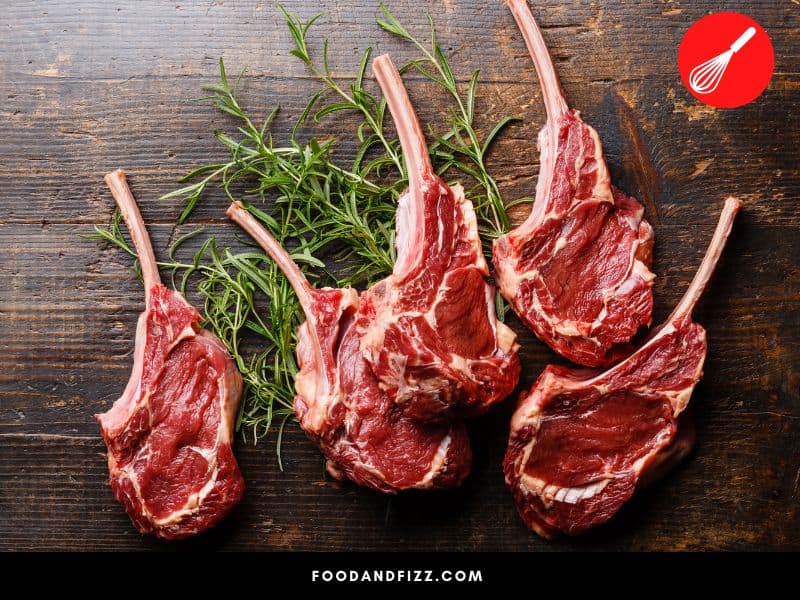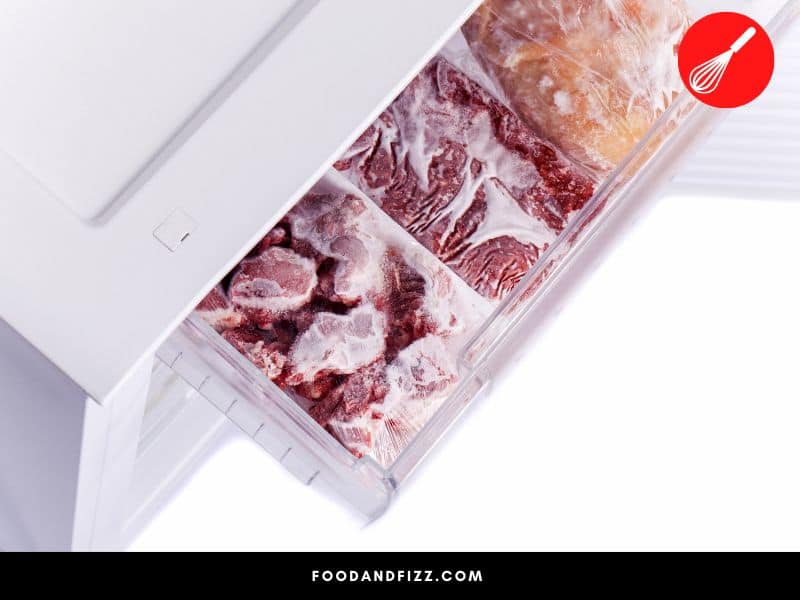Meat changes its color and appearance as it interacts with the elements of its environment, specifically oxygen and heat. Exposure to air and the application of heat changes its intrinsic characteristics.
Oxygen plays a huge role in turning red meat’s characteristic bright red color into a purple-red or brown color through its interaction with the protein myoglobin. When heat is applied, the meat goes through a chemical process that involves this same protein, which changes its color depending on the temperature.
But what processes are involved when the meat turns white instead? Why does meat sometimes turn white when it is cooked?
Why Does Meat Turn White When Cooked?
Meat turns white when cooked because the application of heat causes its proteins to denature or break down, and then reassemble again or coagulate to form a different protein structure that makes the meat more opaque or white in color. This is typically more apparent with what is called “white” meat, such as poultry and fish. In red meat, the change in color can mostly be attributed to the protein myoglobin.

Why Did My Meat Turn White After Cooking?
The application of heat changes the flavor, texture, and color of meat. This is why raw meat looks very much different from cooked meat.
So you place a piece of meat over the heat and find that it suddenly turned white. What caused it to do so?
We’ll explore some concepts that may explain it below.
Denaturation and Coagulation
When meat is subjected to unusual conditions in its environment, such as intense heat, the proteins in it break down and change their nature and structure in processes known as denaturation and coagulation.
When meat is heated through cooking, the proteins in it unravel and become denatured, or in simple terms, they become completely different and exhibit different characteristics.
This breaking down of their innate structure is what allows them to later recombine with other protein molecules to “reassemble” and form a completely different protein, which exhibits different physical characteristics, for example, from a liquid state to a solid state.
To illustrate, we can use the easy-to-understand example of cooking eggs. When egg whites are raw, they are clear and watery. When you apply heat to them in cooking, the proteins in the egg whites begin to denature and break down and change characteristics in response to the agitation of heat.
This breaking down allows them to recombine and reform with other protein molecules to end up with egg whites that are white in color and more solid in texture.
No longer are the egg whites clear and watery, but they are white and solid. The egg whites are forever changed by the heat of cooking, and cannot go back to their previous form.
Relating this to our question at hand, meat may turn white when cooked because of these same concepts of denaturation and coagulation.
When meat is exposed to high temperatures, the proteins in it denature or break down, and allow them to coagulate, reassemble and recombine to form something that looks very much different from its earlier form.

Myoglobin
Myoglobin is an iron-containing protein that is responsible for giving the meat its reddish and pinkish color. The higher the concentration of myoglobin the meat contains, the redder or the darker it will appear.
Beef typically has more myoglobin than poultry, with pork being somewhere in between.
Myoglobin supplies oxygen to the muscles, like what hemoglobin does for our blood cells. Its relationship with oxygen—the presence or absence of it—determines the color of the meat. With little to no oxygen, meat can turn purple-red (as in vacuum-packed meat).
When exposed to air, it will turn a bright cherry red which is the color associated with freshness. The iron in the myoglobin is able to bind with the oxygen, thus maintaining the bright red color.
After a few days, though, the iron in the myoglobin will exhaust its ability to bind with oxygen and eventually oxidize and turn the meat brown, similar to the process of rusting.
In response to heat, myoglobin also plays a role in the meat’s color. At 140°F, myoglobin is stable and there is no change in the color, which is why rare beef is bright red in color.
Above that temperature, the myoglobin becomes agitated, and the iron in it loses its ability to pair up with oxygen (which means it cannot maintain the reddish color anymore) and produces a compound called hemichrome, which gives the meat a light tan color.
As the temperature further increases, more hemichrome is produced until eventually the meat is turned into a gray-brown color that’s typical of well-done meat.
Myoglobin, therefore, plays a huge role in the color of the meat both before and after cooking.
If your meat has turned white or a light color after cooking, it may possibly be related to the compounds produced or the changes in the myoglobin in response to heat.

Do All Types of Meat Turn White After Cooking?
All types of meat undergo chemical changes as they are subjected to heat. These chemical changes include changes in color, texture, and flavor.
Red meat and white meat are comprised of different types of muscles, which explains why they look and taste different.
Red meat vs White Meat
Red meat or dark meat is typically comprised of muscles called “slow-twitch” muscles. These muscles are used for activities that are undertaken for long stretches of time, such as walking or standing.
Because these muscles have to be used for long periods of time, they need a constant source of energy to fuel them. This is where myoglobin comes in. Since myoglobin is responsible for bringing oxygen, and therefore sustenance, to the muscles, this is found in abundance in red meat or dark meat. Myoglobin is also highly pigmented, which would explain the dark, reddish color of red meat.
White meat, on the other hand, is comprised of mostly “fast-twitch” muscles, which from the name, we can understand is used for sudden bursts of activity, such as flying to a tree branch or fleeing to escape a predator.
The main fuel source of this type of muscle is glycogen, which is stored in the muscles. Because fast twitch muscles do not really rely on oxygen as a fuel source, they do not have much myoglobin in them, which is why white meat appears lighter, and turns white when cooked.
White meat, when raw, has an almost glassy and translucent appearance. When it is subjected to heat, it turns an opaque white.
So to answer the question, do all types of meat turn white when cooked? We can say that meat undergoes color changes when heat is applied but meat turning white is something that is typically more readily observed in white meats like chicken and fish, which do not have much myoglobin (and therefore pigmented red color) to begin with, and makes it easier for this type of color change to be observed.
Red meat undergoes color changes as well though and passes a stage where the meat turns tan or light-brown, so it is possible for red meat to turn a lighter color as well, depending on time and temperature.
Can Raw Meat Turn White?
Other Things That Denature Proteins
It is not just heat that can turn meat white or denature it. The addition of an acid like vinegar or lemon juice and high amounts of salt, or mechanical agitation of the substance (as in whipping egg whites) can also cause denaturing.
For example, you might notice that ceviche is white even though it is raw food and was not subjected to heat. This is because the addition of an acid like lime juice caused the proteins to denature.
The acid “cooked” the fish and turned it into a white color. Like cooking over heat, you can oversoak and overcook your fish in acid, resulting in an unpleasant chewy texture.
Salting and brining meat also denatures proteins, and causes changes in its color and texture.

Storage and Handling
Aside from adding ingredients to the meat, how it was stored and handled can also cause it to turn white.
Meat can appear white due to congealed fat in meat, for example in fatty ground beef. At low temperatures, fat can congeal and solidify and leave white spots in meat. If the white spots are fat, heating will dissolve the fat and get rid of the white spots in your meat.
Sometimes, color changes also occur because of the way it was stored. Freezer burn is a common cause of color and texture changes in raw meat.
When meat is frozen, ice crystals from the water molecules first go to the food’s surface. Eventually, these frozen water molecules leave the food and migrate to the coldest part of the freezer, resulting in moisture loss for the meat. This moisture loss causes the meat to dry out and shrivel up.
Because water molecules are able to escape, oxygen molecules are able to creep in, starting a process called oxidation. Oxidation causes color and texture changes in meat and may cause your meat to turn white.
If your meat was frozen and then thawed, you will notice that some of the “blood” will drain from your meat. This is actually not blood but myoglobin mixed with water. The removal of some of the myoglobin due to the thawing process can make your meat look paler, and thus look whiter when cooked.

Is Meat That Has Turned White Safe to Eat?
As long as your meat was handled and stored properly, does not show any signs of food spoilage, and is cooked to the required minimum safe internal temperature, it is safe to eat.
In most cases, meat turning white is a natural result of denaturing meat in the cooking process, or a result of the interaction of the meat with the ingredients added to it, or a result of oxidation.
Frequently Asked Questions to Why Does Meat Turn White When Cooked?
Why Did My Uncooked Meat Turn White In the Fridge?
If your meat does not show any signs of food spoilage but turned white in the fridge, it is likely due to congealed fat or freezer burn. Fat solidifies at lower temperatures so if you see white spots in your package of meat, it may likely be the culprit. If your meat was frozen before and then thawed, it may likely be due to freezer burn.
Why Is My Cooked Steak Pale?
Color changes in red meat are due to the action of the pigment-rich protein myoglobin in the presence of heat. When the steak is cooked at higher temperatures, a tan-colored compound called hemichrome is released, which changes the meat’s color from reddish to pinkish, to tan and eventually grayish brown. If your steak is pale, it is likely due to the natural color changes that happen as the meat is cooked.
Conclusion to Why Does Meat Turn White When Cooked?
When heat is applied to meat, the proteins in it denature or break down, and reassemble to form a protein with different characteristics from the original protein.
White meat starts out as glassy and somewhat translucent, but when heat is applied, the protein restructures to make it white and opaque. Red meat also undergoes color changes when heat is applied, mostly due to the interaction of the pigmented protein myoglobin with the external environment.

